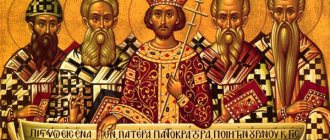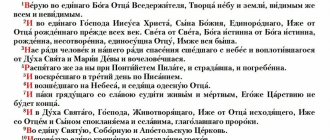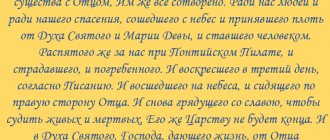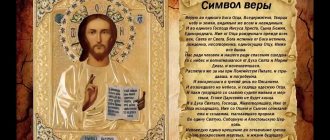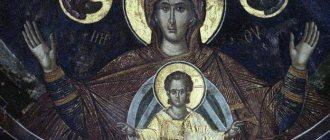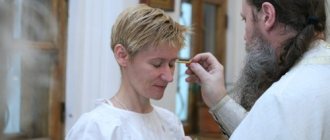The meaning of the word bysha
How can you not remember Habakkuk here: “And seeing your prison before you and the three of you standing in prayer in your prison, and from you three pillars of fire stand stretched out to heaven”; and again: “My tongue spread and became very great, then my teeth became great, and my arms and legs became great, then it became wide and spacious, spread under the sky throughout the whole earth, and then God contained heaven and earth in me , and all creation"?
the likeness of the former, having already been in fasting and in prayer and spiritual asceticism and shining in this life like the stars of heaven and showing great victory to the enemies, the beauty of this vain world was far from itself rejected and the glory of this charming light was not counted for anything, but always with their most pure souls desiring in that never-ending age future lives and pleasures with the Lord God and with His saints, the angels, with the prophets and apostles and martyrs, as is prepared for them
And when she was happy, she began to stretch out her cold voices, like a pleading, taking away from the saint the gift of God, which God promised to eat even after her inseparable death.
They are angry for the sake of the past, not knowing the future, and saying with an oath, as if “if you speak, you will swear with one word without contradiction.”
In the same chapter, verse 5, it is said: “And a mouth was given to him, saying great things and blasphemous things, and he was given the province to do the month four ten two.”
The soldiers answered, saying: neither, but it is worthy for you first to give us Joseph, for today you are torturing us about Jesus without knowing, but you yourself do not know how Joseph was brought out of prison: for we also do not know how Jesus was risen, came from the tomb and is invisible And so it came to pass that women were invisible: therefore give Joseph, and the lady Jesus to you.”
Cyril II, when he received the desired book and became acquainted with it, testified at the Vladimir Council that the church rules, previously unreasonable for the Russians as darkened by the cloud of wisdom of the Greek language, “now they have been leafed out, they have been interpreted, and with the grace of God they shine clearly, driving away the darkness of ignorance and everything is enlightened by intelligent light" 1.
However, one can understand the expression “interpreted bysha” in the testimony we are considering literally and see in the words of the Metropolitan the idea that the church rules were previously incomprehensible to the Russians due to the imperfections of the Slavic translation, which was obscured by many Hellenisms, and also because they had no interpretations , and now acquired in a new Slavic translation and with interpretations, which is why they shine brightly and drive away the darkness of ignorance, although, we admit, this darkness of ignorance involuntarily forces one to assume not only the incomprehensibility of church rules for Russians in the past, but their complete unknownness or inaccessibility to understanding .
A later commentator noticed a number of gaps in the main text and explained them by the fact that “the names were written in this approved letter from memory... new lists at that time (!) were soon not found.”
The soldiers answered, saying: neither, but it is worthy for you first to give us Joseph, for today you are torturing us about Jesus without knowing, but you yourself do not know how Joseph was brought out of prison: for we also do not know how Jesus was resurrected, came from the tomb and is invisible And so it came to pass that women were invisible: therefore give Joseph, and the lady Jesus to you.”
What do the words “Imzhe all bysha” mean?
Words of the Creed “To Him all things were”
show that God the Father created everything with His Son, as His eternal Wisdom and His eternal Word.
“All things came into being through Him, and without Him nothing came into being that was made”
(John 1:3).
St. John of Damascus teaches more about the mystery of the birth of the Son of God:
“(We believe) ... in one Only Begotten Son of God, our Lord, Jesus Christ, begotten of the Father before all ages, Light from Light, true God from true God, begotten, uncreated, consubstantial with the Father, through whom all things came into being. Speaking about Him: before all ages, we show that His birth is timeless and without beginning; for it was not out of non-existence that the Son of God was brought into being, the radiance of glory and the image of the Hypostasis of the Father (Heb. 1:3), living wisdom and power, the hypostatic Word, the essential, perfect and living image of the invisible God; but He was ever with the Father and in the Father, from Whom He was born eternally and without beginning. For the Father never existed unless the Son existed, but together the Father and together also the Son, begotten of Him. For the Father without the Son would not be called Father; if he had ever existed without the Son, he would not have been the Father, and if later he began to have a Son, then he also became a Father after not having previously been a Father, and would have undergone a change in that , not being the Father, became Him, and such a thought is more terrible than any blasphemy, for it cannot be said of God that He does not have the natural power of birth, and the power of birth consists in the ability to give birth from oneself, i.e. from its own essence, a being similar to itself by nature.
So, it would be impious to assert about the birth of the Son that it happened in time and that the existence of the Son began after the Father. For we confess the birth of the Son from the Father, that is, from His nature. And if we do not admit that the Son initially existed together with the Father, from Whom He was born, then we introduce a change in the Hypostasis of the Father in that the Father, not being the Father, later became the Father. True, creation came into existence after, but not from the being of God; but by the will and power of God she was brought from non-existence into existence, and therefore no change occurred in the nature of God. For birth consists in the fact that from the essence of the one who gives birth, that which is born is produced, similar in essence; creation and creation consists in the fact that what is created and created comes from the outside, and not from the essence of the creator and creator, and is completely unlike in nature.
Therefore, in God, Who alone is impassive, unchangeable, immutable and always the same, both birth and creation are impassive. For - being by nature dispassionate and alien to flow, because he is simple and uncomplicated, He cannot be subject to either suffering or flow, either in birth or in creation, and has no need for anyone’s assistance. But birth (in Him) is beginningless and eternal, since it is the action of His nature and comes from His being, otherwise the one who gives birth would have suffered a change, and there would have been God first and God subsequent, and multiplication would have occurred...
So, the ever-present God gives birth to His Word, perfect without beginning and without end, so that God, who has a higher time and nature and being, does not give birth in time. Man, as it is obvious, gives birth in the opposite way, because he is subject to birth, and decay, and expiration, and reproduction, and is clothed with a body, and in human nature there is a male and female sex, and the husband has a need for the support of his wife. But may He be merciful who is above all and who surpasses all thought and understanding.
So, the Holy Catholic and Apostolic Church teaches together both about the Father and about His Only Begotten Son, born from Him without flight, without flow, dispassionately and incomprehensibly - as only the God of all knows. Just as fire and the light that comes from it exist together - not first fire, and then light, but together - and just as light, always born from fire, is always in fire and is never separated from it - so the Son is born from the Father, in no way separating from Him, but always abiding in Him. But light, inseparably born from fire and always abiding in it, does not have its own hypostasis in comparison with fire, for it is a natural property of fire; The Only Begotten Son of God, born from the Father inseparably and inseparably and always abiding in Him, has His own Hypostasis, in comparison with the Hypostasis of the Father.
So, the Son is called Word and radiance, because he was born from the Father without any combination and dispassionately, and without flight, and without flow, and inseparably; (called) the Son and the image of the Father's Hypostasis because He is perfect, hypostatic and in everything like the Father, except for unbornness; (called) the Only Begotten because He alone was born from one Father in a unique way, for no other birth is like the birth of the Son of God, and there is no other Son of God. The Holy Spirit, although it comes from the Father, does not follow the image of birth, but the image of procession. Here is another way of being, as incomprehensible and unknown as the birth of the Son (of God). Therefore, everything that the Father has, the Son also has, except ungeneracy, which does not mean a difference in essence or dignity, but a way of being - just like Adam, who is unborn, for he is the creation of God, and Seth, who is begotten, for he is the son of Adam, and Eve, who came out of Adam’s rib, for she was not born, differ from each other not by nature, for they are people, but by way of being...
You should also know that the names of fatherland, sonship and procession were not transferred from us to the blessed Divinity, but, on the contrary, were transferred to us from there, as the divine apostle says: “For this purpose I bow my knees before the Father of our Lord Jesus Christ, from whom all things are named. fatherland in heaven and on earth"
(Eph. 3:14–15).
If we say that the Father is the beginning of the Son and is greater than Him (John 14:28), then we do not show that He takes precedence over the Son in time or in nature; for through Him the Father “made the eyelids”
(Heb. 1, 2). It does not take precedence in any other respect, if not in relation to the cause; that is, because the Son was born from the Father, and not the Father from the Son, that the Father is the author of the Son by nature, just as we do not say that fire comes from light, but, on the contrary, light from fire. So, when we hear that the Father is the beginning and greater than the Son, we must understand the Father as the cause. And just as we do not say that fire is of one essence, and light is of another, so it is impossible to say that the Father is of one essence, and the Son is different, but (both) are one and the same. And just as we say that fire shines through the light coming out of it, and we do not believe that the light coming from fire is its service organ, but, on the contrary, is its natural power; So we say about the Father, that everything that the Father does, he does through His Only Begotten Son, not as through a ministerial instrument, but as through a natural and hypostatic Power; and just as we say that fire illuminates and again we say that the light of fire illuminates, so everything that the Father does, “then the Son also does” (John 5:19). But light does not have a special hypostasis from fire; The Son is a perfect Hypostasis, inseparable from the Father’s Hypostasis, as we showed above. It is impossible for an image to be found among creatures that in all similarities shows in itself the properties of the Holy Trinity. For what is created and complex, fleeting and changeable, describable and imageable and perishable—how can one accurately explain the all-essential Divine essence, which is alien to all this? And it is known that every creature is subject to most of these properties and, by its very nature, is subject to decay” (23).
Questions for the lesson:
Symbol of faith
1. I believe in one God, the Father, Almighty, Creator of heaven and earth, visible to all and invisible. I believe in one God the Father: I believe that God contains everything in His power and controls everything, that He created heaven and earth, the visible and invisible world. With these words we are saying that we are sure that God exists, that He is One and there is no other besides Him, that everything that exists (both in the visible physical world and in the invisible, spiritual), i.e. the entire vast universe was created by God. And we accept this faith with all our hearts. Faith in God is confidence in the real existence of God and trust in Him. God is one, but not lonely, because God is one in His essence, but trinitarian in Persons: Father, Son and Holy Spirit - the Trinity is consubstantial (i.e., the three Persons of the Holy Trinity have one essence) and inseparable. The Unity of Three Persons who endlessly love each other.
2. And in one Lord Jesus Christ, the Son of God, the only begotten, who was born of the Father before all ages, Light from Light, true God from true God, begotten, not created, consubstantial with the Father, by whom all things were. I believe that our Lord Jesus Christ is the same One and Only God, the second Person of the Holy Trinity. He is the Only Begotten Son of God the Father, born before the beginning of time, that is, when there was no time yet. He, like Light from Light, is also inseparable from the sun. He is the True God, born of the True God. He was born, and not at all created by God the Father, that is, He is one being with the Father, Consubstantial with Him. By Him, everything that happened means that everything that exists was created by Him, as well as by God the Father, the Creator of heaven and earth. This means that the world was created by one God - the Holy Trinity.
3. For our sake, man and our salvation came down from heaven, and became incarnate from the Holy Spirit and the Virgin Mary, and became human. I believe that for the salvation of our human race He appeared on earth, became incarnate from the Holy Spirit and the Virgin Mary, and became human, that is, he took on not only the body, but also the human soul and became a perfect man, without ceasing at the same time to be God - became a God-man. The Holy Orthodox Church calls the Virgin Mary the Mother of God and honors Her above all created beings, not only people, but also Angels, since She is the Mother of the Lord Himself.
4. She was crucified for us under Pontius Pilate, and suffered and was buried. I believe that the Lord Jesus Christ, during the time of the Roman governor of Judea, Pontius Pilate, was crucified on the cross for us people, that is, for our sins and for our salvation, because He Himself was sinless. At the same time, He really suffered, died and was buried. The Savior suffered, of course, not as Divinity, which does not suffer, but as humanity; He suffered not for His sins, which He did not have, but for the sins of the entire human race.
5. And he rose again on the third day, according to the Scriptures. I believe that He rose again on the third day after His death, as foretold in Scripture. The Lord Jesus Christ truly died for us - as the True Immortal God, and therefore He rose again! Since in the writings of the prophets of the Old Testament it was clearly predicted about the suffering, death, burial of the Savior and His resurrection, that is why it is said: “according to the scriptures.” The words “according to the scriptures” refer not only to the fifth, but also to the fourth member of the Creed. Jesus Christ died on Good Friday at about three o'clock in the afternoon, and rose again after midnight on Saturday on the first day of the week, called from that time “Sunday”. But in those days, even part of a day was taken as a whole day, which is why it is said that He was in the tomb for three days.
6. And ascended into heaven and sits at the right hand of the Father. I believe that the Lord Jesus Christ, on the fortieth day after His Resurrection, ascended into heaven with His most pure flesh and sat down at the right hand (on the right side) of God the Father. The Lord Jesus Christ ascended into heaven with His humanity (flesh and soul), and with His Divinity He always remained with the Father. “Seated at the right hand of the Father” means: on the right side, in first place, in glory. These words express that the human soul and body of Jesus Christ received the same glory that Christ has according to His Divinity. By His ascension, our Lord Jesus Christ united the earthly with the heavenly, and glorified our human nature, exalting it to the throne of God; He showed us that our fatherland is in heaven, in the Kingdom of God, which is now open to all who truly believe in Him.
7. And again the one who comes with glory will be judged by the living and the dead, and His kingdom will have no end. Paki - again; coming - the One who will come. I believe that Jesus Christ will come to earth again to judge all people, both living and dead, who will then be resurrected; and that after this Last Judgment the Kingdom of Christ will come, which will never end. This judgment is called terrible because the conscience of every person will open before everyone, and not only the good and evil deeds that someone has done throughout his life on earth will be revealed, but also all the words spoken, secret desires and thoughts. According to this judgment, the righteous will go into eternal life, and the sinners into eternal torment - because they did evil deeds, which they did not repent of and which they did not atone for with good deeds and correction of life.
8. (I believe) And in the Holy Spirit, the Lord, the Life-Giving One, who proceeds from the Father, who is worshiped and glorified with the Father and the Son, who spoke the prophets. Who proceeds from the Father - Who proceeds from the Father; Who is worshiped and glorified with the Father and the Son - Who should be worshiped and Who should be glorified equally with the Father and the Son. The prophets spoke - the one who spoke through the prophets. I believe that the third Person of the Holy Trinity is the Holy Spirit, as true the Lord God as the Father and the Son. I believe that the Holy Spirit is the Life-Giving Spirit, He, together with God the Father and God the Son, gives life to everything, especially spiritual life to people. He is the same Creator of the world, along with the Father and the Son, and He should be worshiped and glorified in the same way. I also believe that the Holy Spirit spoke through the prophets and apostles, and through His inspiration all the Holy Books were written. We are talking here about the main thing in our faith - about the mystery of the Holy Trinity: our one God is the Father, the Son, and the Holy Spirit. The Holy Spirit revealed itself to people in a visible way: at the baptism of the Lord in the form of a dove, and on the day of Pentecost He descended on the apostles in the form of tongues of fire.
9. (I believe) In one holy, catholic and apostolic Church. I believe in one, Holy, Catholic Church (in which all believers participate), founded by the apostles. Here we are talking about the Church of Christ, which Jesus Christ founded on earth for the sanctification of sinful people and their reunification with God. The Church is the totality of all Orthodox Christians, living and dead, united by the faith and love of Christ, the hierarchy and the holy sacraments. Each individual Orthodox Christian is called a member, or part of the Church. Consequently, when we say that we believe in one holy, catholic and apostolic Church, then by the Church we mean all the people who profess the same Orthodox faith, and not the building where we go to pray to God, and which is called temple of God.
10. I confess one baptism for the remission of sins. I acknowledge and openly declare that for spiritual rebirth and forgiveness of sins one only needs to receive holy Baptism once. The Creed only mentions baptism, because it is, as it were, the door to the Church of Christ. Only those who have been baptized can participate in other church Sacraments. A sacrament is such a sacred action through which the grace of the Holy Spirit (i.e., the saving power of God) is secretly, invisibly given to a person.
Listen to the Creed in mp3 format:
11. I hope for the resurrection of the dead. I expect (tea) with hope and confidence that a time will come when the souls of dead people will again unite with their bodies and all the dead will come to life. The resurrection of the dead will follow simultaneously with the second and glorious coming of our Lord Jesus Christ. At the moment of the general resurrection, the bodies of dead people will change; In essence, the bodies will be the same as those we now have, but in quality they will be different from the current bodies - they will be spiritual: incorruptible and immortal. The bodies of those people who will still be alive at the second coming of the Savior will also change. According to the change of man himself, the entire visible world will change, namely, from the corruptible to the imperishable.
12. And the life of the next century. Amen. I expect that after the resurrection of the dead, the judgment of Christ will be completed, and for the righteous there will come the endless joy of union with God. The word Amen means confirmation - truly so! Only in this way can the truth of our faith be expressed and cannot be changed by anyone.
Part two. Interpretation of the Creed. Introduction.
Ancient philosophers called man a “microcosm,” that is, a small world. St. the fathers agreed with this name, St. Gregory of Nyssa wrote that man is “a certain small world containing within itself the same elements with which the universe is filled,” which “embraces every kind of life”246.
At the same time, St. fathers’ attitude to the name “microcosm” was different from that which took place in antiquity. For pagan sages, this is a proud name that expresses the greatness of a person, while among the Church Fathers there is an openly ironic attitude towards this term. St. Gregory of Nyssa notes: “They said: man is a microcosm... but with this name giving such praise to human nature, they did not notice that they honored man with the properties of a mosquito and mice”247.
For St. fathers, the greatness of man lies not in what unites him with the cosmos, but in what, on the contrary, sets him apart from the natural world. What distinguishes man is the image of his creation and existence: in the image of God.
“And God said: Let us make man in Our image, after Our likeness... And God created man in His own image, in the image of God He created him...”
(Gen. 1:27).
The concept of “image of God” is not disclosed in the Holy Scriptures, and the patristic literature contains a wide range of opinions on this issue. However, all Sts. the fathers agree that the image of God consists in man’s ability to reflect Divine perfections. For example, God is the absolute Spirit, and man has an immaterial component - the soul (Clement of Alexandria, St. Gregory of Nyssa, St. Augustine). God is absolute reason, and man is also a rational being (Clement of Alexandria, St. Augustine). God is eternal, the reflection of eternity in man is immortality (St. Maximus the Confessor, Blessed Augustine). God reigns over the whole world, and man is also endowed with royal dignity, called to rule over the Universe (St. John Chrysostom, St. Gregory of Nyssa)248.
However, St. the fathers, recognizing that man was created in the image of God, do not consider it possible to give the image of God a formal definition. St. Epiphanius of Cyprus (402) writes: “Church teaching believes that man is generally created in the image of God, but it does not determine in what part exactly that which is in the image of God is found”249.
Moreover, many Church Fathers (Schm. Irenaeus of Lyons, St. Gregory of Nyssa, St. Gregory Palamas) believe that not only the soul, but also the human body participates in conformity with God250. Modern Orthodox anthropology, relying on patristic teaching, comes to the conclusion that the image of God “does not refer to any one element of the human composition, but to all human nature as a whole” 251.
St. Philaret of Moscow, saying that man reflects the perfections of the Creator differently from other creations, oh, but the image of the face of God is found only in man.”252
Unlike all other creatures, man is not only involved in the Divine, but is able to freely participate in Divine perfections and stand before God face to face. But it may not be what is coming, but who, that is, a person. Thus, we can say that the actual godlikeness of man lies not in the nature of man, which is radically different from the uncreated Divine nature, but in the way of his existence, which is personal for both God and man. Consequently, the image of God in man consists, first of all, in the fact that man is a personal being, and in this impersonal world he alone is a personal image of the personal God. Thus, modern Orthodox theology makes a distinction between the actual image of God, which is a characteristic of the way of existence of nature, and the features of the image of God, that is, those properties of human nature in which God-likeness is specifically manifested253.
Most Sts. Fathers and modern theologians distinguish between the concepts of “image of God” and “likeness of God.” This difference is established on the basis of Gen. 1:26–27: God’s will for the creation of man contains both elements, image and likeness, while creation has only one – image.
Image and likeness are closely related to each other and cannot be understood in isolation from one another. The image of God is God’s gift to every person, which is expressed in the ability to be a partaker of Divine life, to participate in Divine perfections, and likeness is the manifestation of this gift in a person’s life and the measure to which this ability is realized. We can say that image and likeness are two aspects of a dual concept. The image of God is what was initially given to a person, while the likeness is a certain predetermination, a task that a person must solve throughout his life. The features of the image of God relate to the essence of man and are essential properties of human nature, while the features of similarity are revealed as a result of the orientation of the human will towards good. The features of the image are the properties of nature, thanks to which a person can improve, become like God, reflecting the perfections of his Creator, for example, rationality, the gift of speech, and the like. Using these abilities in an appropriate way, a person can achieve godlikeness, acquiring, for example, goodness and wisdom, which are no longer traits of an image, but of likeness. Almost all people possess traits of the image of God, while not everyone reveals traits of likeness. Nevertheless, it is possible to talk about image and likeness as a dual concept. After all, God-likeness potentially contains God-likeness, and likeness is the revelation of God-likeness in human life. This makes possible the interchangeability of the terms “image” and “likeness” in the Holy Scriptures and in some saints. fathers without compromising the meaning254.
It should be noted that the features of the image of God themselves, neither individually nor collectively, exhaust human godlikeness. For various reasons, certain features of the image of God, for example, rationality, may not appear in some people, however, it is impossible to deny human dignity to these people, since they can also be partakers of the Divine life. The constitutive principle of man as a person is not this or that characteristic of his nature, but the love of God addressed to him255. It is the breath of God, the Divine love present in a person, that makes him a god-like being, a person.
